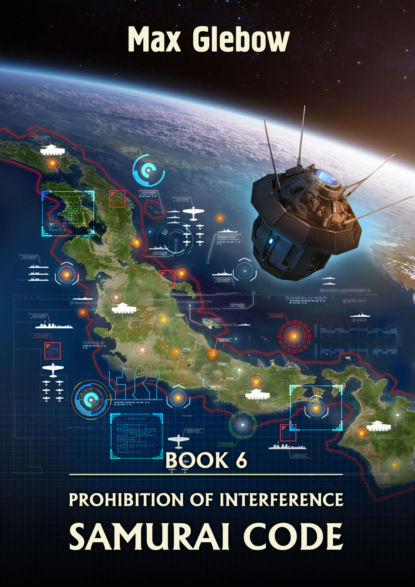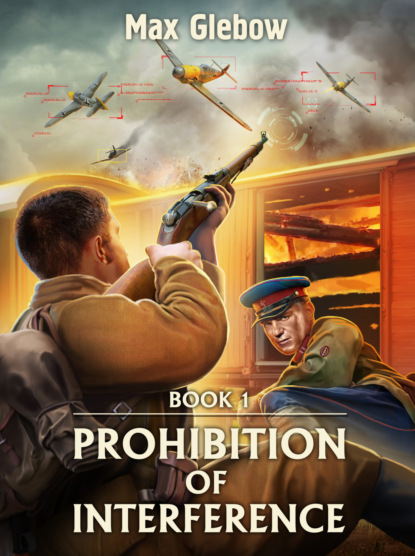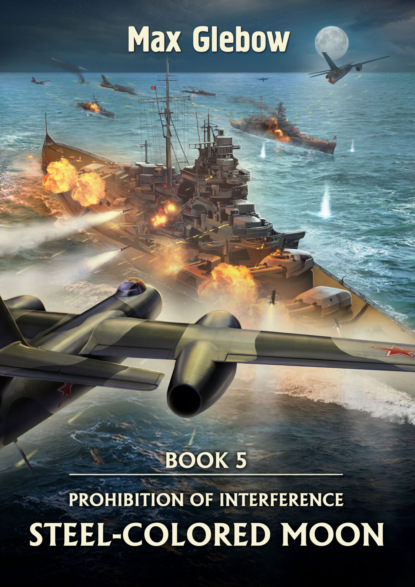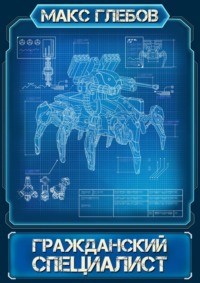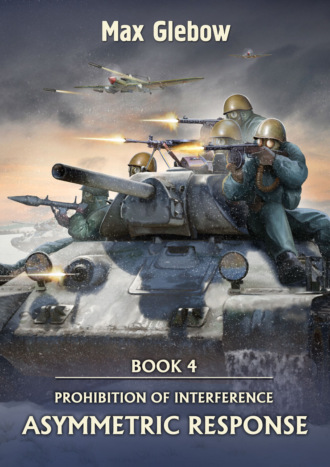
Полная версия
Prohibition of Interference. Book 4. Asymmetric response
I left Shaposhnikov, to put it mildly, not in the best mood. What can I do against a horde of transport planes, densely covered by evil Messerschmitts? Use my "air defense cruiser," a homemade conversion of the TB-7? That's ridiculous. In the daytime, the Messerschmitts would pile in and tear it to shreds, losing at best a few planes. We could, of course, bomb airfields at night, but that would probably do little, and our losses would probably be heavy – the Germans are no fools, and they learn from their own experience very quickly.
So I have to use anti-aircraft guns, they're not bad in the Red Army, but it's not so easy here either. A stationary bridge over the Dnieper River or enemy tanks and armored personnel carriers huddled in a small area is one thing, but aircraft flying at high altitude is quite another.
The muzzle velocity of the only flak suitable for my targets is 800 meters per second. The projectile will have to fly seven to eight kilometers, and mostly upwards. It will reach its target in 15 seconds or even 20 seconds after the shot. During this time, the aircraft can make several maneuvers, both horizontally and vertically. And if you consider that there are over a thousand of these planes, I'll just get pretty tired of shooting them down. This will take several months, which no one will give me, and, above all, the Germans themselves will not give me any time.
Chapter 2
I continued to live in Lubyanka, which suited me fine, since it allowed me to see Lena regularly. Together with Ignatov and Nikiforov she became subordinate to Lieutenant Colonel Lebedev, who, at my request, began to prepare from them a combat troika of saboteurs. Lena entered as a sniper, Ignatov as a grenade launcher, and Nikiforov was assigned the role of machine gunner.
Depending on the task at hand, the group of saboteurs could also include other fighters. For example, a radio operator, a sapper, a guide, or two or three gunners who were members of the grenade launcher and machine gun teams, but three soldiers always formed the core of the group. Lebedev liked my idea and was preparing several such threesomes at once, but only Lena and the sergeants continued to serve in Moscow next to me, even though I didn't seem to be directly involved with them anymore.
I shook my head, bringing my thoughts back to the matter at hand. I immediately dismissed the idea of sitting in the gunner's seat of one of the anti-aircraft guns myself, since I obviously would not be able to shoot down so many planes, to make a big difference in a few days.
I was sitting and thinking about the situation when the door opened and Lena walked quietly into the room.
“What's the matter?” She asked worriedly when she saw my grim face.
“Well, nothing bad's happened yet,” I tried to smile as nonchalantly as possible, “It's just that the Headquarters of the Supreme High Command want me to break the Germans' air bridge to the Moscow Pocket, and I'm trying to figure out if I'm up to the task of breaking it.”
“If the bosses think you can do it, then be kind enough to break it,” Lena replied without smiling, but I could see from her eyes that she didn't really mean it.
“Maybe you can tell me how to do it?” I asked just as jokingly.
“What's there to think about?” Lena was surprised, “Who set you the task?”
“Comrade Shaposhnikov did.”
“There!” Lena said, holding up her index finger, “Which means what? It means that your resources are virtually unlimited. You're not a battalion or regiment commander, for whom such an order would be absurd. You are a direct subordinate of the Chief of General Staff. That is, you have to carry out this order with the help of the units and formations that the Headquarters of the Supreme High Command will allocate for the task at hand. Have you been told what you can dispose of yet?”
“No,” I looked at Lena with surprise, she suddenly showed herself in a completely unexpected way. “They're expecting an operation plan from me by this evening.”
“So what's the problem? You didn't have a problem pointing heavy howitzers at ground targets, so why would it be different with aerial targets? Remember how many guns were working for you near Moscow. Many hundreds! I do not think that, having set such a task, the Headquarters of the Supreme High Command will be greedy in forces and means. Ask for as many anti-aircraft guns and planes as you need. Without any false modesty, which, however, as far as I know, you don't have,” Lena smiled.
I looked at my girlfriend in silence. Her simple words acted as a switch for my brain, that put my mind in the right direction. After all, it's true that I should no longer rely solely on my own abilities. If I want to get to a really strategic level, it's time to bring in resources of an appropriate scale. And this task will be another test for me. It was not for nothing that the order sounded so abstract. The means of carrying it out are left entirely up to me, which means that the Headquarters of the Supreme High Command wish to see, how I'm going to get out of this situation.
“Lena, you're good,” I caught her hand and pulled her to me.
“Come on,” she waved me off, putting her hands on my chest, “What did I say that was so important?”
“It's up to me to decide if it's important or not,” I wrapped my arms around her tighter and lifted her slightly. Lena let out a soft chuckle and tried to wriggle out, but she didn't try very hard.
* * *Sergeant Serova almost missed Lebedev's class on general sabotage training and left my room in quite a hurry, and I, after mindlessly lying in bed for a few minutes, got the computer to give me a reference about the flight routes and tactics of German transport planes.
The Germans had enough airfields inside the Moscow Pocket. The perimeter of the encirclement was gradually shrinking, of course, but the enemy could still safely receive transport planes in a dozen places, and this ensured the rapid distribution of received supplies to units and formations.
It cannot be said that the Luftwaffe was able to completely ignore our aircraft, but the Germans quickly found effective tactics to counteract the few Soviet fighters. They did not stretch their Messerschmitts along the routes of the transport planes, and besides, they would not have had enough fighters to do so. The Junkers and Heinkels flew in tight groups of 30–50 planes at an altitude of about 5,000 meters. Such a group of planes could defend itself even without fighter cover, keeping a tight machine-gun fire on any enemy who dared to approach it. Nevertheless, there was a cover-up. The Messerschmitts patrolled the skies directly over the transport planes and ahead on their course, making sure no one tried to hurt their clumsy wards.
The anti-aircraft gunners, of course, tried to bombard the Germans over the territory occupied by our troops, but the enemy was constantly changing flight paths, and the Soviet commanders could not guess where exactly the anti-aircraft guns should be concentrated. The enemy, of course, had losses, but I would not call them significant. This was the situation I needed to change.
To begin with, I tried to estimate the forces that were already present in the sector between the inner and outer fronts of the encirclement, which was not too wide. There were a surprising number of anti-aircraft guns. Why be surprised, though? We had to make up for German air superiority in some way, otherwise it would have been difficult for the ground troops. Rifle divisions did not have 85 mm anti-aircraft guns. They were combined into anti-aircraft regiments of 16 guns each and into anti-tank brigades, where these guns acted as regular guns. Now it was up to me to extract all this wealth from the clinging hands of commanders at various levels in the name of achieving the single goal of destroying the German air bridge.
Around 7 p.m. I was already in Shaposhnikov's office with the report that the operation plan was ready. The Marshal accepted the folder from my hands and asked me to tell him the main idea. I said it.
“The air defense positioning areas?” Shaposhnikov said thoughtfully, listening carefully to my report. “This idea is unusual, but generally understandable. However, that is not all. You want to ensure high mobility of anti-aircraft units by saturating them with tractors beyond the norms… It won't be easy to do, and I'm afraid the equipment will have to be taken away from the artillery regiments…”
“Comrade Marshal, without mobility we can't do anything. Anti-aircraft regiments must be able to maneuver quickly within the position area, otherwise the enemy will simply start routing transport planes to bypass the identified air defense sites and try to suppress them with artillery and aviation. ”
“Okay, let's say you're right. But there is another questionable point in your plan – controlling the fire of several position areas from a single center. As I understand it, you want to transmit data directly, by radio and telephone, for input to PUAZO-3s, the artillery anti-aircraft fire control devices?”
“Yes, Comrade Marshal.”
“How do you plan to have time to receive data from radars and air defense posts, process it and transmit it to the 12 position areas? The slightest delay in data transmission will cause them to lose relevance. Are you sure you can handle it?”
“I'm sure. If it weren't for PUAZO, I really wouldn't have time to do all this, but these automatic devices will do some of the work for me, and the anti-aircraft batteries would be able to open fire in time. In addition, all 12 regiments of 52k are unlikely to fire at the same time.”

Artillery anti-aircraft fire control unit PUAZO-3. Developed in 1939. In August 1940 it passed testing, was accepted for service and put into series production. A significant disadvantage of PUAZO-3 was the large combat crew of seven men, who manually entered into PUAZO the data taken from the rangefinder about the range, altitude, and direction of target movement, as well as meteorological data on wind speed and air temperature and humidity. Another problem was that the PUAZO-3, like similar devices of previous models, provided data only on visually observed targets.
To be honest, the PUAZO-3s, with which the batteries of 85mm anti-aircraft guns were equipped, were very primitive devices, but for the 1940s of the 20th century they represented a significant step forward in anti-aircraft fire control. A crew of seven men entered data from rangefinders and radars into the PUAZO, the device calculated the coordinates of the target and lead and transmitted data to the guns for firing.
For me the value of this system was that the anti-aircraft gunners were good with it and I had no need to control the fire of each gun, but I could greatly increase the accuracy of the data, entered into the fire control device, and that should have made a big difference in the efficiency of the firing.
“Okay,” Shaposhnikov finally made a decision, “I will present your plan to the Headquarters of the Supreme High Command. I hope, Comrade Nagulin, you realize the degree of responsibility you are taking on. To conduct this operation, we will have to overhaul the entire system of anti-aircraft coverage of the outer front of the encirclement.”
* * *The air bridge was impressive. The satellites allowed me to see it in all its glory. This was probably the first time in Earth's history that a warring party has conducted such a large-scale supply operation using transport aircraft.
Of course, no uninterrupted line of planes flying in a chain stretching for hundreds of kilometers was observed.This tactic can be used only in the absence of any opposition from the enemy. A stretched chain of transport planes can be attacked anywhere, and there are not enough fighters to cover the whole 'sausage'. Therefore, the Germans used the method of "air convoys", they gathered Junkers and Heinkels in groups and escorted them to the airfields in the Moscow Pocket.
There were five or seven air groups in the air at one time. Together with their fighters, they each had about 50 planes. The Germans chose different routes, but in any case they had to overcome the territory occupied by our troops.
I, of course, could not predict the path of each particular plane, but the computer processed an array of information on all German flights into the pocket and identified the most promising locations for the deployment of air defense positioning areas. Now any group of Luftwaffe transport planes trying to break through to the surrounded troops would come within range of at least one of my 12 anti-aircraft regiments, on average, three times out of five.
In case the Germans changed their flight patterns, reserve positions were prepared in each area, and the anti-aircraft gunners could quickly move their 85 mm guns there. Naturally, the armament of the air defense position areas was not limited to 52-K guns alone. The medium-caliber anti-aircraft guns, not very effective against low-flying targets, were densely covered by automatic guns of the more modest caliber – 37 and 20 millimeters.
My interaction with the range and radar posts, as usual, was largely a spectacle, and I was honestly playing my part in this one-actor theater. To those around me, the scheme of my work looked something like this: the RUS-2 "Redoubt" radar stations were the first to spot groups of German planes. These stations transmitted data on the altitude, course and speed of the target to my command post. Then the airborne observation, warning, and communications posts set up surveillance of the enemy, and when it became clear whose area of responsibility the Junkers were flying into, I put the appropriate air defense positioning area on alert.
It was believed that, based on the information I received from the rangefinder and radar posts, I would calculate the initial data for the PUAZO and transmit it to the batteries of 85 mm anti-aircraft guns by radio in telegraph mode. In reality, of course, all this could not work, but I tried very hard to make my tumultuous activities look as realistic as possible. In fact, it was the computer transmitting data for the PUAZO to the batteries via the nearest satellite. For the radio operators who received these signals and the anti-aircraft fire control device teams, as well as for the soldiers and commanders who helped me organize the work at the command post, everything looked quite natural. The signals, of course, passed without any delays and interference, and were corrected by the computer, taking into account the time required for data input and processing.
It took three days to deploy and set up the air defense system. I closely followed the movements of the Germans. So far, they were not ready to launch either a conventional or a chemical attack. According to my estimates, the enemy needed about a week more, so I had some time at my disposal, although knowing the Germans, I could expect them to strike in a shorter time.
“Comrade Lieutenant Colonel, the check is over. All communication channels are functioning normally. We can switch the flow of data to you.”
“Turn it on.”
I put on my headphones and sat down in a chair around which there were transmission equipment and telephone exchange on the tables and on the floor. All this electromechanical equipment was flashing with a multitude of neon lights and scales of devices, and there was a multitude of wires all around. I reminded myself of a character in a rather funny comedy about a mad professor who fell into the past together with his student; the film I had seen as a child, a long time ago.
The first report came in just a couple of minutes.
“"Mole", this is "Owl 4". We have a signal! Target is group. Altitude 5,300, speed 320, distance 105, course… ”
Within a short time I received reports of two more groups of German planes. In fact, there were more of them, but not all of them were in the field of vision of the "Redoubts". Well, the first to go into battle was the air defense positioning area south of Vyazma, and then two more anti-aircraft regiments would have to act, unless, of course, the Germans decided to change course abruptly. In fact, they didn't usually do that, though, and I saw no reason for the enemy to change his habits yet.
“"Viper-2", this is "Mole". There's a group of Junkers coming your way. Altitude 5,300. Approach time, 19 minutes. Prepare to receive data for fire control.”
* * *By the beginning of the battle for Moscow, Oberleutnant Heinz Baer had already taken part in the Battle of Britain, where he almost died when his damaged Messerschmitt was shot down by a Spitfire that jumped out of the clouds and fell into the waters of the English Channel. To the pilot's misfortune this scene, not the most epic of his career, was observed from the shore by Reichsmarshal Göring himself, who did not fail to personally express to Bair, who was then still a non-commissioned officer, his highest displeasure. However, after his transfer to the Eastern Front he quickly began to increase his air victories, and in July 1941 he was promoted to lieutenant and awarded the Knight's Cross, and in August, when his total number of aircraft shot down exceeded 60, he received the Oak Leaves to his Cross.
The task of escorting slow transport planes did not please the aggressive fighter pilot. The Junkers, crawling in a tight group, limited his options, tying him down, and preventing him from doing the free hunting that the Oberleutnant loved so much.
Nevertheless, his position as team leader allowed him to take some liberties. In recent days Russian fighter attacks have been infrequent and rather harassing, so Baer ordered his wingman to follow him and, breaking away from the rest of the fighters, flew a couple of kilometers above the transport planes. As a result, the Oberleutnant was at a point very convenient for observing the covered Junkers and the surrounding sky. And there really was something to watch.
First, ahead, a little way off their course, many flashes flickered on the ground. Baer knew that the Russians had good anti-aircraft guns, theoretically capable of reaching enemy aircraft at altitudes of up to ten kilometers. Of course, they were no match for the German 88 mm FlaK, but sometimes they gave the Luftwaffe pilots a hard time.
The 40 Junkers, still in formation, continued to fly forward unperturbed. The first salvo from the Russians usually missed their targets, but it didn't seem to be this time. Most of the bursts occurred to the right and below the transport planes, but about a third of the shells exploded inside their order and scattered lots of shrapnel.
Three Ju-52s began to smoke and started to leave the formation with a descent. One of them began to turn around, while the other two apparently suffered more serious damage and did not take any maneuvers. Soon the domes of parachutes flashed in the sky behind these planes as the crews abandoned the doomed machines. However, the Oberleutnant noted it all only in passing. His attention was fixed on the surviving transport planes.
The Russian anti-aircraft guns kept their maximum rate of fire. For their caliber, one shot in three seconds was very good. The anti-aircraft gunners fired volleys, and to Baer's horror, each successive batch of shells was more and more accurate. Unable to withstand this beating, the Junkers broke formation in an attempt to disperse, but they were clearly too late – at least half the transport planes were already hurtling toward the ground, smoking thickly with burning engines or falling to pieces right in the air.
Now the Oberleutnant understood what the glossy Oberst from the Abwehr was talking about, who a couple of days ago was instructing all fighter group commanders, assigned to protect the air bridge. Baer turned on his radio transmitter, but all he heard in his headphones was a howl of interference. With a flap of his wings, he ordered his wingman to follow him and sent his Messerschmitt into a sharp turn with a descent. In the event of an interruption of radio communication, the order explicitly required Baer to return immediately to the airfield and report the coordinates of the position of the Russian anti-aircraft gunners, who demonstrated an accuracy of firing never seen before.
* * *Oberleutnant Baer's report on the defeat of the group of Junkers guarded by his fighters caught Richtengden at the Luftwaffe Second Air Fleet's reserve command post. After listening to the cover group commander, the Colonel turned sharply to the officer on duty. He no longer had any doubts – the marksman was on the move.
“Hauptmann, get the special group in the air! The task is to attack Russian anti-aircraft positions south of Vyazma,” Richtengden himself took the sheet with the exact coordinates of the target from the communicator and handed it to the Luftwaffe officer.
Ten minutes later, 12 Messerschmitts and 32 Ju-87 dive bombers were in the air. For the first time on the Eastern Front, they carried not only high-explosive bombs but also chemical ones in their bomb chambers. The Colonel was well aware that right now he was committing the irreversible act that could change the entire balance of power in this war. Of course, his plan was coordinated at the very top, but it was he who came up with the idea and the decisive order also came out of his mouth, which means that he, too, will be responsible for the consequences.
Seven minutes passed in tense anticipation, which was suddenly interrupted by the sharp buzzer of the telephone.
“Herr Oberst, the Headquarters of the Eighth Air Corps is on the line.”
“I'm listening,” said the Colonel into the receiver.
“Herr Oberst, Hauptmann Meyer reports. The group of Heinkels, escorted by my squadron, was hit by Russian 85 mm anti-aircraft guns, lost more than half of its planes and was scattered. According to the order, I have to report such cases immediately…”
“I'm already aware of that, Hauptmann. Those anti-aircraft guns near Vyazma will soon be finished.”
“Excuse me, Herr Oberst, did you say near Vyazma? My air group came under Russian fire northeast of Rzhev.”
“Of Rzhev? Are you sure, Hauptmann?”
“We managed to spot the positions of the anti-aircraft guns. They are about 30 kilometers from the outer front of the encirclement. I'm ready to give you the exact coordinates.”
“Thank you, Hauptmann,” said Richtengden in a colorless voice, “the liaison officer on duty will take your coordinates.”
The Colonel pondered the information for about 15 seconds and then turned his gaze to the Luftwaffe officer.
“I need a connection with the special group. It's urgent! They must return to the airfield immediately!”
“There is no communication, Herr Oberst,” the officer on duty reported after a minute, “the airwaves are again clogged with these anomalous interference…”
The Hauptmann had no time to finish – he was interrupted by another call signal. Richtengden slowly turned to the communicator.
“Herr Oberst, this is Oberleutnant Eichenwald, Third Fighter Squadron, Eighth Air Corps.”
The Colonel silently took the receiver, already realizing what he was about to hear.
* * *The "Redoubt" teams were unable to detect nearly five dozen German planes taking off from two nearby airfields, but the computer immediately drew my attention to something out of the usual pattern of enemy activity.
This new air group consisted exclusively of fighters and dive bombers. It did not have a single transport aircraft, hence, it had to perform tasks far removed from those of supplying the encircled German armies.
After a couple of minutes, when the enemy planes finally came together and lay on a course for Vyazma, their intentions became crystal clear to me. Unlike the transports, the dive bombers kept low, trying to stay close to the ground to reduce the chance of detection by radars and air traffic control stations.
“"Viper 2", this is "Mole". A group of dive-bombers covered by Messerschmitts is approaching you from the southwest. 30 to 40 Ju-87s. Flying time 12 minutes.”


